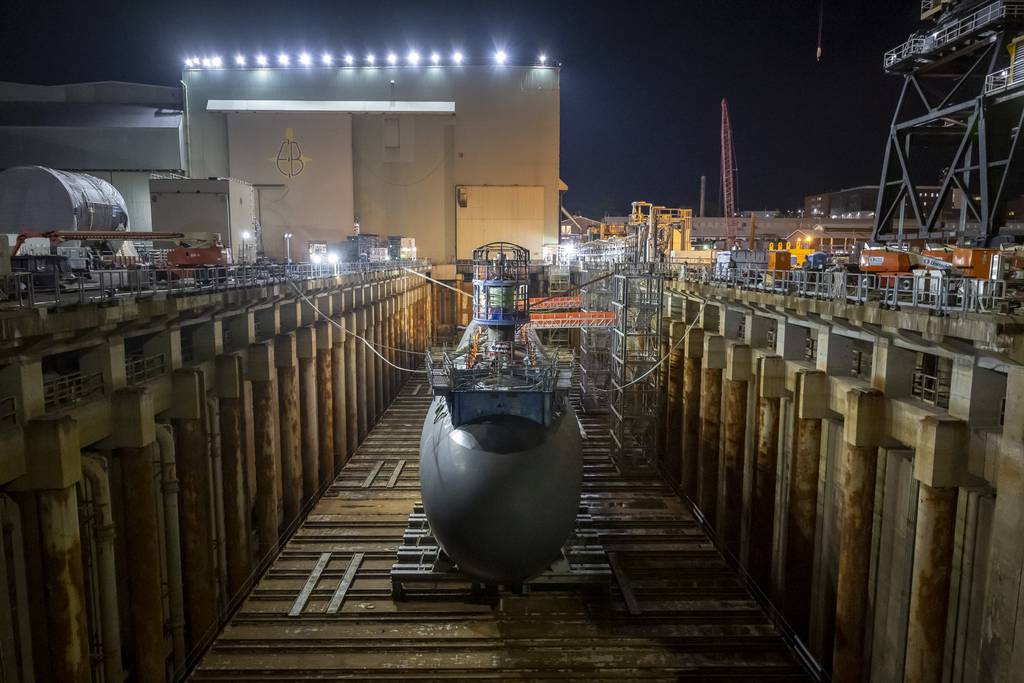
ARLINGTON, Va. — The U.S. Navy and the submarine sector hope in 2024 they can begin reliably delivering two attack submarines annually, following work disruptions that threw off plans to do so this year.
Industry delivered one attack sub, the Hyman G. Rickover, this calendar year and will send a second, the New Jersey, to sea trials in December ahead of delivery early next year.
Rear Adm. Jon Rucker, the program executive officer for attack submarines, said his office enacted new construction and delivery timelines in February to begin achieving two-sub deliveries a year in 2023.
But almost immediately his office fell behind.
In addition to some unspecified issues that arose over the summer, General Dynamics Electric Boat had to delay launching a submarine in the spring when its launch pontoon broke, creating a backup of modules and parts since it didn’t have the space to let new material flow into its construction facilities until the boat left.
Rucker called the summer a low point in Virginia-class attack submarine production, but he said the overall production rate was already up and should be back to a 2.0 delivery cadence by fiscal 2028.
The Navy and industry are at a 1.3 attack sub construction cadence, which means all the phases of submarine construction — manufacturing, outfitting, assembly, final test and delivery — are humming along at a rate that would support delivering that number of subs year over year.
By the end of this calendar year, Rucker said while speaking at the Naval Submarine League’s annual symposium, the work across all phases of construction will be “rebalanced” after this summer’s backups, and the cadence should be able to continue creeping up toward the 2.0 goal.
The Navy has poured billions of dollars into the submarine-industrial base since FY18 to address some of the cadence issues. Matt Sermon, the executive director of Program Executive Office Strategic Submarines, told Defense News at the conference that investments from FY19 through FY21 targeting sequence-critical parts that were showing up late — forcing the construction process to either pause and wait, or continue without the part and then try to install it later in a costly or disruptive way — would help submarines under construction today.
For the Block V Virginia-class subs, as well as the second Columbia-class ballistic missile submarine that just formally began construction last month, “we’re going to see improvements in that space” as the vendors use the Navy’s money to expand facilities or improve work processes, and thus deliver their parts on time, Sermon added.
Boats in construction now will also benefit from workforce development spending, Sermon said, as key suppliers have been able to hire highly skilled tradesmen from formal training pipelines like the Accelerated Training in Defense Manufacturing center in Virginia.
In FY24, the Navy plans to fund about 50 supplier development projects. The supplier development projects are still targeting sequence-critical parts: either new parts that have started delivering late and putting construction schedules at risk, or parts whose manufacturers have already received some money but need more help, Sermon said.
If there’s any leftover money, Sermon added, the Navy will begin targeting other suppliers who either can’t keep up with delivery schedules today, or who aren’t expected to keep up as the workload increases in the coming years.
Whitney Jones, the director of the Navy’s submarine-industrial base program, said her office is trying to take a smarter approach to where it puts this money.
“Historically, we have often looked at how we’re making these investments at a supplier level, and it’s been very whack-a-mole: For every one we address, five more pop up. It’s a challenge. What we have shifted to is looking at the health of a market space or the health of a commodity group, and figuring out where the investments need to be made for the health of a space,” she told Defense News.
Megan Eckstein is the naval warfare reporter at Defense News. She has covered military news since 2009, with a focus on U.S. Navy and Marine Corps operations, acquisition programs and budgets. She has reported from four geographic fleets and is happiest when she’s filing stories from a ship. Megan is a University of Maryland alumna.
- SEO Powered Content & PR Distribution. Get Amplified Today.
- PlatoData.Network Vertical Generative Ai. Empower Yourself. Access Here.
- PlatoAiStream. Web3 Intelligence. Knowledge Amplified. Access Here.
- PlatoESG. Carbon, CleanTech, Energy, Environment, Solar, Waste Management. Access Here.
- PlatoHealth. Biotech and Clinical Trials Intelligence. Access Here.
- Source: https://www.defensenews.com/naval/2023/11/09/us-navy-eyes-two-submarine-delivery-rate-in-2024-after-schedule-upset/



